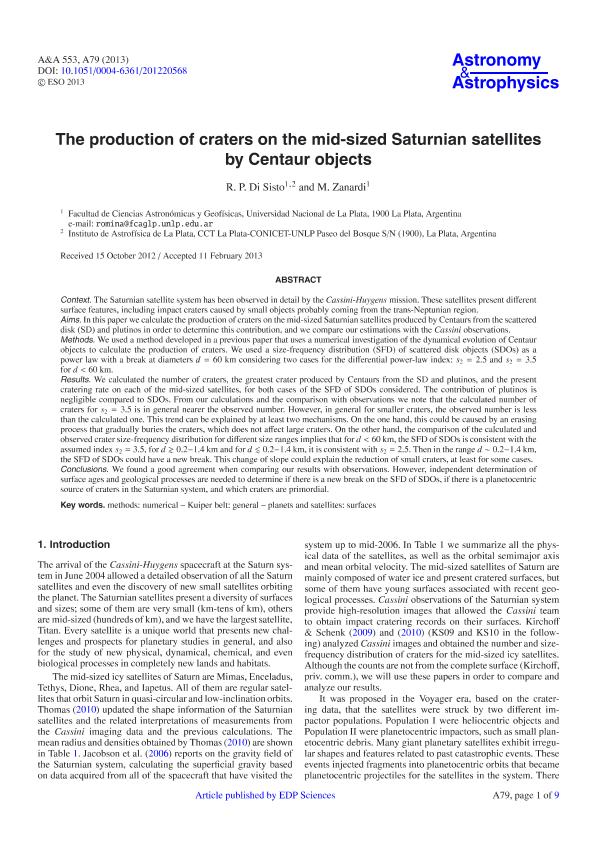Mostrar el registro sencillo del ítem
dc.contributor.author
Di Sisto, Romina Paula

dc.contributor.author
Zanardi, M.
dc.date.available
2017-01-02T14:46:19Z
dc.date.issued
2013-05
dc.identifier.citation
Di Sisto, Romina Paula; Zanardi, M.; The production of craters on the mid-sized saturnian satelites by Centaur objects; Edp Sciences; Astronomy And Astrophysics; 533; 5-2013; 1-9
dc.identifier.issn
0004-6361
dc.identifier.uri
http://hdl.handle.net/11336/10663
dc.description.abstract
Context. The Saturnian satellite system has been observed in detail by the Cassini-Huygens mission. These satellites present different surface features, including impact craters caused by small objects probably coming from the trans-Neptunian region.
Aims. In this paper we calculate the production of craters on the mid-sized Saturnian satellites produced by Centaurs from the scattered disk (SD) and plutinos in order to determine this contribution, and we compare our estimations with the Cassini observations.
Methods. We used a method developed in a previous paper that uses a numerical investigation of the dynamical evolution of Centaur objects to calculate the production of craters. We used a size-frequency distribution (SFD) of scattered disk objects (SDOs) as a power law with a break at diameters d = 60 km considering two cases for the differential power-law index: s2 = 2.5 and s2 = 3.5 for d < 60 km.
Results. We calculated the number of craters, the greatest crater produced by Centaurs from the SD and plutinos, and the present cratering rate on each of the mid-sized satellites, for both cases of the SFD of SDOs considered. The contribution of plutinos is negligible compared to SDOs. From our calculations and the comparison with observations we note that the calculated number of craters for s2 = 3.5 is in general nearer the observed number. However, in general for smaller craters, the observed number is less than the calculated one. This trend can be explained by at least two mechanisms. On the one hand, this could be caused by an erasing process that gradually buries the craters, which does not affect large craters. On the other hand, the comparison of the calculated and observed crater size-frequency distribution for different size ranges implies that for d < 60 km, the SFD of SDOs is consistent with the assumed index s2 = 3.5, for d ≳ 0.2−1.4 km and for d ≲ 0.2−1.4 km, it is consistent with s2 = 2.5. Then in the range d ~ 0.2−1.4 km, the SFD of SDOs could have a new break. This change of slope could explain the reduction of small craters, at least for some cases.
Conclusions. We found a good agreement when comparing our results with observations. However, independent determination of surface ages and geological processes are needed to determine if there is a new break on the SFD of SDOs, if there is a planetocentric source of craters in the Saturnian system, and which craters are primordial.
dc.format
application/pdf
dc.language.iso
eng
dc.publisher
Edp Sciences

dc.rights
info:eu-repo/semantics/openAccess
dc.rights.uri
https://creativecommons.org/licenses/by-nc-sa/2.5/ar/
dc.subject
Numerical Methods
dc.subject
Planets
dc.subject
Satellites
dc.subject
Kuiper Belt
dc.subject.classification
Astronomía

dc.subject.classification
Ciencias Físicas

dc.subject.classification
CIENCIAS NATURALES Y EXACTAS

dc.title
The production of craters on the mid-sized saturnian satelites by Centaur objects
dc.type
info:eu-repo/semantics/article
dc.type
info:ar-repo/semantics/artículo
dc.type
info:eu-repo/semantics/publishedVersion
dc.date.updated
2016-11-18T15:11:10Z
dc.journal.volume
533
dc.journal.pagination
1-9
dc.journal.pais
Francia

dc.journal.ciudad
Paris
dc.description.fil
Fil: Di Sisto, Romina Paula. Universidad Nacional de la Plata. Facultad de Ciencias Astronómicas y Geofísicas; Argentina. Consejo Nacional de Investigaciones Científicas y Técnicas. Centro Científico Tecnológico la Plata. Instituto de Astrofísica de la Plata; Argentina
dc.description.fil
Fil: Zanardi, M.. Universidad Nacional de la Plata. Facultad de Ciencias Astronómicas y Geofísicas; Argentina
dc.journal.title
Astronomy And Astrophysics

dc.relation.alternativeid
info:eu-repo/semantics/altIdentifier/url/http://www.aanda.org/articles/aa/abs/2013/05/aa20568-12/aa20568-12.html
dc.relation.alternativeid
info:eu-repo/semantics/altIdentifier/url/http://dx.doi.org/10.1051/0004-6361/201220568
Archivos asociados
